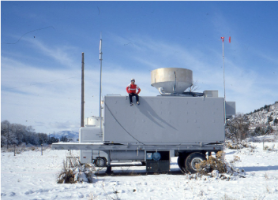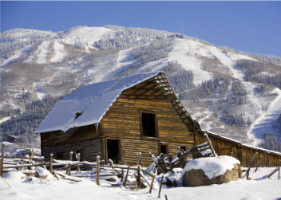Winter snowstorms in the mountains of the western United States provide the water that drives the economy of the Western United States, and, in many ways, the country itself. Snow is necessary for a robust tourist industry, but more importantly, meltwater from winter snowfall is the primary source of agricultural and urban water supplies, and provides much of the area’s power supply through hydroelectric power generation. In the southwestern states that depend on the Colorado River, water from annual snowfall is barely adequate for water supplies during years of normal snowfall. Since the discovery of cloud seeding effects by Schaefer and Vonnegut in the late 1940s, seeding of wintertime mountain cloud systems has been pursued as a technology to increase water supplies. My research has involved determining the efficacy of wintertime orographic cloud seeding, particularly evaluating the hypothesis that underlie the principles of cloud seeding. My work has particularly focused on natural cloud processes, understanding the fundamental cloud physics and dynamics that determine the structure and evolution of clouds over the mountains of the western United States. My early work focused on clouds over Northwest Colorado in the area of Steamboat Springs. My work then took me to the Sierra Nevada, where we studied cloud systems over the Lake Tahoe region. Most recently I participated in the SNOWIE field campaign working with Idaho Power studying cloud seeding over the mountains of Idaho. This work is in collaboration with scientists at NCAR, and the Universities of Wyoming and Colorado.
Publications
- Rauber, R. M., D. Feng, L. O. Grant, and J. B. Snider, 1986: The characteristics and distribution of cloud water over the mountains of northern Colorado during wintertime storms. Part I: Temporal variations. J. Climate Appl. Meteor., 25, 468–488.
- Rauber, R. M., and L. O. Grant, 1986: The characteristics and distribution of cloud water over the mountains of northern Colorado during winter-time storms. Part II: Spatial distribution and microphysical characteristics. J. Climate Appl. Meteor., 25, 489–504.
- Sassen, K., R. M. Rauber, and J. B. Snider, 1986: Multiple remote sensor observations of supercooled liquid water in a winter storm at Beaver, Utah. J. Climate Appl. Meteor., 25, 825–834.
- Cotton, W. R., G. J. Tripoli, R. M. Rauber, and E. Mulvihill, 1986: Numerical simulation of the effects of varying ice crystal nucleation rates and aggregation processes on orographic snowfall. J. Climate Appl. Meteor., 25, 1658–1680.
- Rauber, R. M., and L. O. Grant, 1987: Supercooled liquid water structure of a shallow orographic cloud system in southern Utah. J. Climate Appl. Meteor., 26, 208–215.
- Rauber, R. M., 1987: Characteristics of cloud ice and precipitation during wintertime storms over the mountains of northern Colorado. J. Climate Appl. Meteor., 26, 488–524.
- Heggli, M. F., R. M. Rauber, and J. B. Snider, 1987: Field evaluation of the dual-channel microwave radiometer. J. Atmos. Oceanic Tech., 4, 204–213.
- Blumenstein, R. R., R. M. Rauber, L. O. Grant, and W. G. Finnegan, 1987: Application of ice nucleation kinetics in orographic clouds. J. Climate Appl. Meteor., 26, 1363–1376.
- Rauber, R. M., and M. F. Heggli, 1988: The influence of cloud droplets on the measurement of ice particle concentrations with a Particle Measuring System’s 2DC optical array probe. J. Atmos. Oceanic Tech., 5, 123–128.
- Uttal, T., R. M. Rauber, and L. O. Grant, 1988: Distributions of liquid, vapor, and ice in an orographic cloud from field observations. J. Atmos. Sci., 45, 1110–1122.
- Rauber, R. M., R. D. Elliott, J. O. Rhea, A. W. Huggins, and D. W. Reynolds, 1988: A diagnostic technique for targeting during airborne seeding experiments in wintertime storms over the Sierra Nevada. J. Appl. Meteor., 27, 811–828.
- Grant, L. O., and R. M. Rauber, 1988: Radar observations of wintertime mountain clouds over Colorado and Utah. J. Wea. Modif., 20, 37–43.
- Heggli, M. R., and R. M. Rauber, 1988: The characteristics and evolution of supercooled water in wintertime storms over the Sierra Nevada: A summary of microwave radiometric measurements taken during the Sierra Cooperative Pilot Project. J. Appl. Meteor., 27, 989–1015.
- Rauber, R.M., 1991: Microphysical structure and evolution of a central Sierra Nevada orographic cloud system. J. Appl. Meteor., 31, 3-24.


